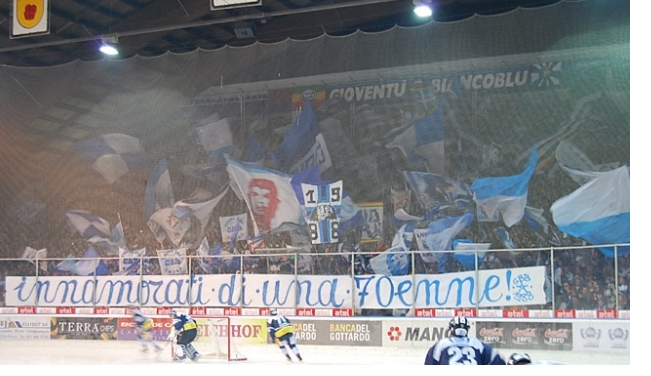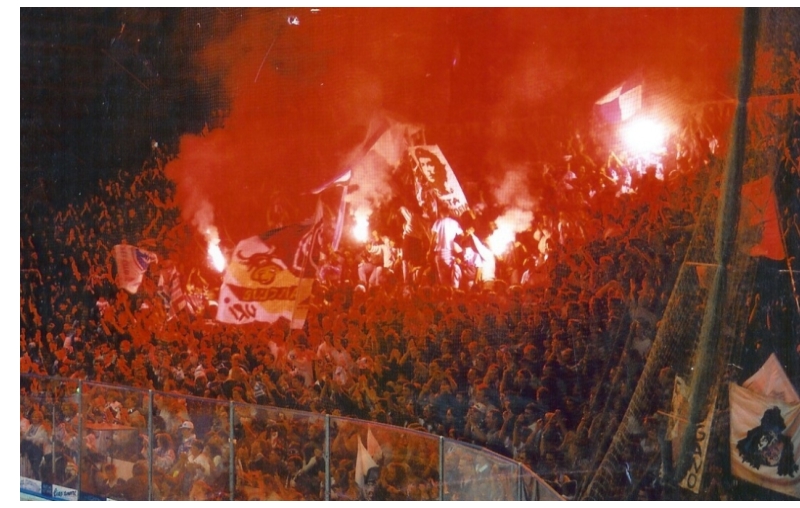Passione unica!
Riporto un articolo pubblicato l’anno scorso su Alpine Anarchist Productions e che parla della squadra di hockey su ghiaccio che seguo.
"Only few places in European hockey can become as intimidating as the Valascia."
C’è da andarne fieri:)
What Does Geronimo have to do with Ice Hockey? An Excursion to a Swiss Valley
 My contribution to Give ‘em the Lumber 2 was the account of an unsuccessful search for radical hockey culture in what was supposed to be perfect terrain for such an endeavor: Sweden. Luckily, the European possibilities for an overlap of slapshots and righteous politics do not end in Malmö.
My contribution to Give ‘em the Lumber 2 was the account of an unsuccessful search for radical hockey culture in what was supposed to be perfect terrain for such an endeavor: Sweden. Luckily, the European possibilities for an overlap of slapshots and righteous politics do not end in Malmö.
Enter Ticino, the Italian-speaking part of Switzerland – the multilingual Alpine nation that proves that recognizing more than one of its spoken languages as »official« does not inevitably lead to a country’s demise, contrary to what a lot of Anglos in the US still wanna make you believe (even though in this case the demise might be an even better thing than in that of Switzerland – but I’m digressing…).
Ticino is no historical stranger to radical politics. Michael Bakunin lived here in the early 1870s (the »Villa Baronata«, possibly his most famous domicile, still exists in Minusio), and in the early 1900s the community of Monte Verità, near Ascona, developed fame for its free spiritedness, vegetarianism and nudity. Amongst the frequent visitors were German anarchist Erich Mühsam, the Dadaists Emmy and Hugo Ball, the writer Hermann Hesse, and the painter Paul Klee. (The Monte Verità still exists as well – in form of a luxury resort.)
Today, it would be difficult to present Ticino as a hotbed of revolutionary activity. Its politics are moderate at best (with the Lega dei Ticinesi, the local right-wingers, w ielding significant influence), its biggest town, Lugano, is Switzerland’s third most important banking center (and this says a lot in a nation whose riches largely rely on banking), and its valleys, mountains, and shores are overrun by affluent German tourists in both summer and winter. Nonetheless, this is where our radical hockey story begins.
ielding significant influence), its biggest town, Lugano, is Switzerland’s third most important banking center (and this says a lot in a nation whose riches largely rely on banking), and its valleys, mountains, and shores are overrun by affluent German tourists in both summer and winter. Nonetheless, this is where our radical hockey story begins.
The set-up is well-known: David vs. Goliath, the underdog vs. the champion, the Irish vs. the English – whichever way you want it. The opponents in this case are, on the one hand, the HC Lugano, the banking city’s hockey club pride, one of the most successful in the history of Swiss hockey and these days without doubt one of its richest (mainly thanks to the investments of controversial businessman Geo Mantegazza). And on the other hand, the HC Ambri-Piotta, a hockey club tucked away in the Leventina valley whose stadium’s capacity of 7000 becomes somewhat baffling once we consider that the hamlets of Ambri and Piotta (part of the municipality of Quinto) combine for a mere total of a couple of hundred inhabitants. (Unsurprisingly, the hockey club goes as the hamlets’ biggest employer and their economic backbone.) Contrary to the Lugano club, the HC Ambri-Piotta is one of the most unsuccessful clubs in the history of Switzerland’s first hockey league (compare one runner-up achievement in 1999 to seven Lugano championships in the last 20 years) and definitely one of its poorest. Which, combined with its remote location, quaint setting, miniscule hometown and remarkable perseverance (the club’s foundation goes back to 1937, even outdating the Lugano city rival by a few years), provides the charm that makes the club so attractive for the hockey fan with a political edge who wants to feel good about the team he or she supports.
As a result, the HC Ambri-Piotta has attracted left-leaning hockey fans all over Switzerland, and beyond, since the 1980s. This is at least partly the reason why it has one of Europe’s widest spread hockey supporter networks. In Switzerland alone there are about 40 Ambri-Piotta fan clubs, and only a fraction of those are in Ticino itself; the others have their homes in Zurich, Lucerne or Fribourg. Not all of these fan clubs are political, but a fair number of them are. The most notorious – sort of a vanguard amongst the political Ambri fans – is the Gioventù Biancoblu, the »White-Blue Youth«, named after the team’s colors.
Founded in 1988, the Gioventù Biancoblu created an intriguing hockey fan culture by combining two elements that are not exactly common hockey fan culture features: radical politics and the choreographic creativity of the Italian »Ultras«, the die-hard soccer fans who get stadiums all along the boot fired up with witty chants, colorful banners, Bengal lights, and inexhaustible enthusiasm.
As a consequence, the Curva Sud (the »South Bend«), where the Gioventù Biancoblu gather during the team’s home games in the famed Valascia, has earned itself a reputation as one of the hottest spots to be for any passionate hockey fan in Europe, beyond all political allegiances or alpine romanticisms. Klaus Zaugg, legendary Swiss hockey journalist, is on record stating: »There is no greater joy for eyes and ears in the world of hockey – and that includes the NHL.«
Every season’s highlights are the duels with arch-rival Lugano. The atmosphere in Ambri-Piotta’s home arena then reaches its peak. There seems to be some understanding amongst dedicated European hockey fans that you have to make the trip to the Ticino derby in the Valascia at least once in your life. The jubilations after an Ambri victory are a sight to behold and »La Montanara«, the Italian mountain carol adopted as the Ambri fans’ anthem and sung after every victory, rings from the stands at its most impressive. (The song also lends its name to the club’s own magazine.) Needless to say, the grief after a loss can reach according depths. Any hockey fan (or any fan of any sports, for that matter) will sympathize with the Ambri-Piotta supporters’ shock and desperation when their team lost the 2006 best-of-seven quarter finals series of the Swiss championships to Lugano by 3-4 after a 3-0 lead, only to see Lugano go on to win the title.
A quick word about the Valascia itself: The arena is without doubt an essential part of the Ambri folklore. Situated at 3000 ft. above sea-level and open at both ends, it is not only known for freezing temperatures juxtaposing the fires on the stands, but also for anything but state-of-the-art facilities. As a Swiss-German fan once remarked after a visit to the grounds: »Ambri-Piotta is not a rich club. The stadium makes this quite obvious. There is hardly any space, sanitary facilities are old, and there are queues everywhere.« This does indeed sound like everyone used to low-income housing would feel right at home…
The fact that the Valascia can still hold 7000 people owes itself to the arena only providing 2000 seats – the rest is standing only, adding to the Ultra football grounds appeal. As the ambitious online Bernt’s Hockeyarena Guide suggests: »Only few places in European hockey can become as intimidating as the Valascia.«
Finally, the stadium is reportedly the only home arena used by any professional Swiss hockey club that is actually owned by the club itself. Independence ain’t bad. However, in these days of complete out-of-control development there are plans to overhaul the Valascia and turn it into something more »modern«. We’ll see whether the righteous sections of the fans will be able to resist this evilish move.
Speaking of the righteous sections of the fans: No one really knows when, why and how the Che Guevara and Geronimo flags first appeared in the Valascia next to the kaffiyahs, mohawks, and studded leather jackets obligatory for any alternative Western crowd. These days, however, the flags – especially that of Geronimo who beats the nowadays ever-present Che hands down in originality – have become a trademark of the Ambri-Piotta fan appearance.
Sure, serious students of historical materialism or the revolutionary possibilities of syndicalist councils in the 21st century might speak of the Ambri fan crowds, somewhat patronizingly, in the words of a Swiss comrade, as »the dope-smoking left«, but the Gioventù Biancoblu is more than just style and talk. Over the years, its members have raised funds for war refugees, staged events against French nuclear testing in the Pacific, collaborated with aid organizations like African Smile, helped equip Ticino Special Olympics contingents, and organized protests in the Valascia against the US-led invasion of Iraq. Furthermore, they are usually represented with a squad at the Mondiali Antirazzisti, the »Antiracist Soccer World Cup«, held every year in northern Italy, and have been a determined voice in domestic political debates, most recently taking a strong stand against increased state surveillance for the sake of »domestic security« (why should Switzerland make a difference?), not least because such surveillance also impinges significantly on the freedom of sports fans, who – mostly due to the »unruly« mobs they truly or allegedly form – have been deemed a potential risk to those in power for a long time. In Switzerland, individual Ambri-Piotta fans were struck with nationwide stadium bans as early as the 1990s for Ultra antics deemed unacceptable by the authorities.
It ought to be mentioned, too, that besides the political work, the Gioventù Biancoblu does also excel in supporting its club. In 1999, when the HC Ambri-Piotta went through a severe financial crisis, the GBB spearheaded a fan campaign that raised 2.5 Million Swiss Francs and was to a large degree responsible for the club securing its first league license and continuing to hold a professional hockey squad.
If any of the readers of this article familiar with European soccer fan culture are reminded at this point of the FC St. Pauli phenomenon, this is hardly surprising. The parallels are indeed striking. (For those not in the know: The FC St. Pauli is a pretty shitty soccer club out of Hamburg’s harbor/red light district who got adopted by local squatters in the 1980s as »their« club and has since had a tremendously successful career as a radical global darling.) Arguably, if the popularity ratings of soccer and hockey were reversed, it might be Ambri-Piotta shirts that could be seen at Critical Mass Rides in the Bay Area, not those of St. Pauli. However, the parallels do not end with the glory only. Also the mundane reality is the same. While radical elements have a strong influence on the fan culture of both clubs, a majority of their fans is apolitical, and some even dislike the left-wing presence on the stands (there are, for example, Ambri-Piotta fan clubs that loudly campaign for a »de-politization« of the Valascia). In any case, the radicalness ends where the official club structures begin. As there is nothing that distinguishes the administration of the FC St. Pauli from that of any average German soccer club, there is nothing that distinguishes the administration of the HC Ambri-Piotta from that of any average Swiss hockey club. And if we wanted to drive the nail even deeper into the wounds of those who thought they had discovered a virtuous hockey world where the anti-colonial resilience of Asterix’ Gallic village meets the mythical appeal of the noble Italian mountain bandit, we could point out that the origins of the much loved and hyped »La Montanara« lie in the Trentino, a region in the Italian Alps that, apart from its mountainous beauty, is best known for its devout Catholicism, stubborn patriarchy and a proud attachment to the most conservative of traditions.
Then again, where is the point in always focusing on the negative? Thomas Bäumle, current goalkeeper for Ambri-Piotta, and – as once St. Pauli goalkeeper Volker Ippig (is there a pattern here?) – the truest representative of the Ambri-Piotta spirit on the ice, has once explained his dislike of the HC Lugano by calling the club »the home of the worst capitalists«. How much do we yearn for any professional athlete in the US to ever say anything even remotely as heartening? There we already get excited when a Dennis Rodman comes sporting a fresh hairdo alongside custom tattoos and luxury parlor piercings.
While spending time in Lausanne earlier this summer I got talking hockey to one of the local squatters (not just any squatter – this was a squatter who had moved there from Canada – know what I’m sayin’?) who complained that the city’s team had been relegated to Switzerland’s second league. The complaints weren’t based on issues of local pride – the problem was that this meant that Ambri-Piotta wouldn’t come around for games anymore. My point is: The creation of a mountain hamlets’ hockey club to be loved by the radical fan while waving flags of an unyielding Geronimo is not only in full swing, it is working too. And it is up to us to keep it that way.
Nonetheless, the article has to end on a disappointing note. Even during his years with Western Austria’s former European club champion VEU Feldkirch (who has meanwhile lost its professional team due to hazardous financial enterprises – a common feature in Austrian sports), located a mere couple of hundred miles from the Leventina valley, my friend Claus never got to play a game against Ambri-Piotta. I’m sure he played against Lugano, though, in some European club competition. What injustice.





DA VENT’ANNI TIFO, LOTTA E AGGREGAZIONE!
avanti skomposti
avanti gioventù
avanti curva sud
avanti Ambrì Piotta
forza Ambri
avanti curva*sud oltre ogni ostacolo
mai domi.